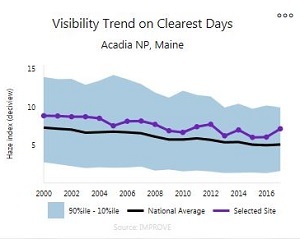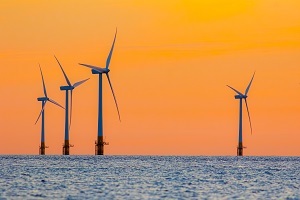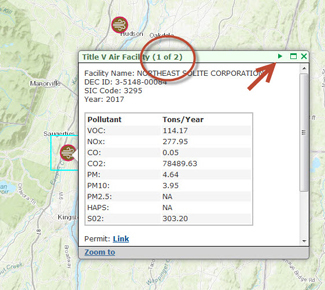Landfill Smells, Clear Views and Clean Energy - Air Mail! Newsletter
The New York State Department of Environmental Conservation sent this bulletin on 08/15/2019 03:24 PM EDT |
| DEC Delivers - Information to keep you connected and informed from the NYS Department of Environmental Conservation |
| Share or view as a web page || Update preferences or unsubscribe |
This Month’s Topics: |
Public & Stakeholder Participation Information
Additional information and access to past announcements are on our Public & Stakeholder Participation Information page. Air Mail! is the publication to announce public and stakeholder information about air quality topics. All NYS residents are environmental stakeholders – we welcome anyone to join the information sessions and other opportunities posted here. Why Do Landfills Smell?Landfills can be stinky, especially when there’s one in your neighborhood, but what makes them smell so bad? Gases, such as ammonia and hydrogen sulfide, are to blame for the characteristic landfill odor. These gases come from decomposing waste in anaerobic conditions, meaning there is no oxygen present. In this environment, the bacteria breaking down the waste produce methane, hydrogen sulfide, and ammonia. In aerobic conditions, when there is oxygen, the bacteria that break down waste release carbon dioxide instead. This kind of decomposition is known to occur in healthy, properly maintained compost piles. Aerobic decomposition results in little to no smell because no hydrogen sulfide or ammonia is produced. Methane, a potent greenhouse gas, can contribute to the formation of ground-level ozone. Ozone is an air pollutant known to cause respiratory issues in people, especially children and the elderly. Prolonged low-level exposure to ammonia and hydrogen sulfide can also have negative health effects, such as eye, nose and throat irritation. DEC regulates gas emissions from landfills to protect public health and minimize odors. A properly designed and maintained landfill should produce very little odor. Remember, if you smell landfill gas, report it by contacting the Regional Air Pollution Control Engineer responsible for the area. You can also minimize your contribution to landfills by composting food waste at home to reduce landfill odors and greenhouse gas emissions. Photo caption: The working face of an active landfill – where the waste is deposited. Decomposition in a landfill starts off aerobically but becomes anaerobic once the waste is buried and the oxygen is used up. Regional Haze Report UpdateThe June 2019 issue of Air Mail! included an article about upcoming revisions to NY’s Regional Haze Plan. The Haze Plan, first developed in 2010, was created to decrease our contribution to reduced visibility in nearby National Parks and wilderness areas. DEC just completed the first draft of the revised State Implementation Plan for Regional Haze – Second Implementation Period to document progress made so far and add programs to be implemented in the future that will improve air quality downwind from NY. You may submit written comments on this draft of the SIP revision until 5 p.m. on September 6, 2019. Remember to check the AQI before you go outside to limit your exposure to air pollution. Graph caption: Graph of haze trends in Acadia National Park since 2000. On average, the amount of haze has been decreasing which means visibility is increasing. Clean Energy on the HorizonOn July 19, 2019, Governor Andrew M. Cuomo, joined by former Vice President Al Gore, signed the Climate Leadership and Community Protection Act (CLCPA), which adopts the most ambitious and comprehensive climate and clean energy legislation in the country. Governor Cuomo’s nation-leading mandate of 6,000 megawatts of solar by 2025, 3,000 megawatts of energy storage by 2030, and 9,000 megawatts of offshore wind by 2035 will contribute to NY’s goal of 100 percent clean electricity by 2040, and a total reduction of 1990 greenhouse gas emission levels by 85 percent in 2050. The CLCPA also requires NY to consider all its stakeholders by investing 40 percent of clean energy resources to benefit disadvantaged Governor Cuomo also executed the nation's largest offshore wind agreement and the single largest renewable energy procurement by any state in U.S. history – nearly 1,700 megawatts. Two offshore wind projects were selected as part of this agreement, and together they will create enough energy to power over 1 million homes. These actions prove that NY will continue to set a standard in air quality and clean energy. Read the press release for more information and comments. DEC Launches New ‘DECinfo Locator’ to Increase Transparency and Access to Data ReportsDEC recently launched DECinfo Locator, an interactive map that provides access to DEC documents and public data about NY's environment and outdoor recreation resources. This first-of-its-kind DEC mapping application generates results specific to locations across NY and includes 50 interactive data layers. Several information layers can be active at the same time, allowing users to see the many ways DEC is working to protect and enhance NY’s environment and recreational opportunities. Among other uses, the public can:
To access the mapping application, visit the DECinfo Locator web page. Learn more about its features from the DECinfo Locator Tutorial on YouTube. Photo caption: An example of the information displayed for a Title V Air Facility. Some locations have multiple records, so click on the arrow to see all the information. Join the Team!Looking for a job that has a positive impact on our environment? DEC offers numerous opportunities for qualified individuals looking to work in environmental fields and support the protection of the environment. Learn more about career opportunities in natural resource management and environmental protection with DEC on our website. Dates to Remember:
Stay Informed about Your Air QualityNYS' ozone season runs from April through September. DEC publishes ground-level ozone forecasts during ozone season, and particulate matter pollution forecasts year-round using a scale called the Air Quality Index (AQI). DEC sends out an air quality alert when there is a high AQI value, which indicates polluted air. Individuals with pre-existing respiratory or cardiovascular conditions and people who exercise outdoors should take caution during an air quality alert. Find out if an Air Quality Alert is in effect by calling the toll-free Ozone Hotline: 1-800-535-1345. The AQI can be accessed in three ways:
We would like to know what you think. Please send your Air Mail! questions or comments to us at DAR.web@dec.ny.gov. |




 communities.
communities.